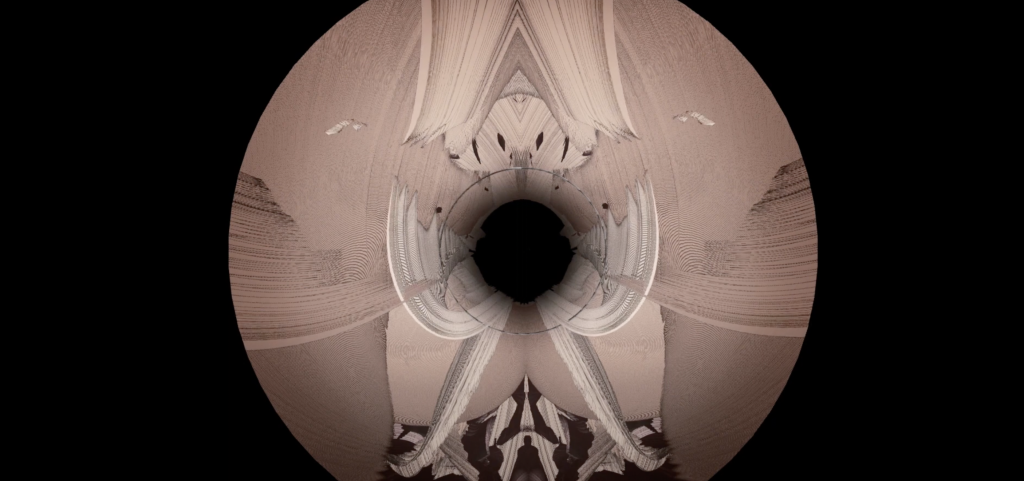Text by CLOT Magazine

Techno polymath Stefan Goldmann is releasing a new album, Vector Rituals (Macro), on May 6. CLOT Magazine today is premiering a video for one of the singles of the album, Ayon, directed by Javier Benjamín, a video artist from Argentina.
Goldmann’s work has always focused on creating his uniquely own form of contemporary art music. In the new album, he explores polymetric rites of percussion. Synthesised from the ground up, timbral characteristics, metric properties, dynamic expression and microrhythmic phrasing are shaped by the interactions of layered control voltage functions. Some of the parametric relationships employed are as loose as to imply chance drifts.
Others lock in with strict regularity, as found in the 13 vs 17 polymeter patterns of the album’s opening track. By contrast, in the strictly repetitive yet highly asymmetrical sequence of ‘Yukagir’, each metric step has its own uniquely irregular duration. The centrepiece of this collection is ‘Ayon’ with multiple autonomous and highly agile timelines. Its constituent layers break away in a radial fashion and fall back, an aspect that is similarly reflected in the video.
Goldmann says he first met Benjamín in Buenos Aires, where he was scheduled to play a show in the dome of CCK, the old central postal office and now a large cultural centre. The venue has an enormous glass dome with a large LED wall and a sound system. With little preparation for that show, Benjamín, while almost improving, achieved some visual results that really impressed Goldmann. Since then, they have worked on numerous audio-visual formats, including concerts at the Berlin Philharmonic’s Grand Hall and at Palacio Alsina in Buenos Aires during Mutek Festival.
When asked about the inspiration behind the video, Goldmann shares that during the early months of the pandemic, they had some time to collaborate remotely and together, both artists developed some work for another Argentinean landmark, the Planetario Galileo Galilei: What you see in the Ayon video is a circle which is the dome of the planetarium, and the middle of the circle is the top of that hemisphere. It is programmed in a way that can be projected in this 360-degree format.
The music works with multiple timelines that disperse in a radial fashion and fall back together at widely spaced points of the congregation. The visual elements experience growth patterns that are driven by those different layers in the music.
The circular structures grow and expand, layer on top of each other as digital generative processes. Getting into details about the more technical process, what Benjamín did was extract data from the audio signal – through processes such as spectral analysis or tracking levels in separate frequency bands – and use this data to control the dimensions and movements of visual objects. To some degree, Goldmann says, the visual it’s growing directly out of the music or elements of the music, but then it also develops a life of its own.
There’s a link between what you hear and what you see that is somewhat obvious, but it is not too obvious, I guess. There’s a lot of autonomy to the visual side, and it’s never just some plain visual representation like a waveform, a spectrum, Lissajous figures…
The capability of generating a lot of the content by analysing the audio stream in real-time makes it possible to avoid many of the rigidity and pre-arranged characters of most AV formats. On the other hand, it’s not as random or basic as many standard VJ-ing techniques. He tells us an example of the adaptability of the system: at Mutek Argentina in 2019, we had prepared an experimental set. When I saw Palacio Alsina, a venue with a floor capacity of 2500 and three stories of galleries on each side I figured this really called for a massive warehouse rave rather than subtlety. We agreed to change the content quite radically.
Within less than 24 hours, the presentation was transformed into a much more aggressively danceable direction based on the asymmetrical metre material from my Veiki album. Thus working with such processes gives you quite an astonishing degree of flexibility. Ironically, I played parts of the set I had originally prepared at London’s Cafe OTO a few days later, hence without the visual layer. This turned out to be a much more appropriate setting.
Pre-order the album here.






